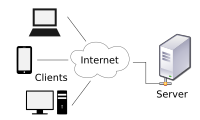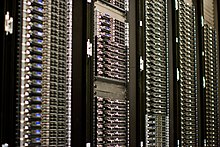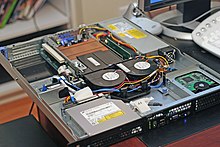Server (computing)
In computing, "server" dates at least to RFC 5 (1969),[5] one of the earliest documents describing ARPANET (the predecessor of Internet), and is contrasted with "user", distinguishing two types of host: "server-host" and "user-host".In the publish-subscribe pattern, clients register with a pub-sub server, subscribing to specified types of messages; this initial registration may be done by request-response.There are exceptions that do not use dedicated servers; for example, peer-to-peer file sharing and some implementations of telephony (e.g. pre-Microsoft Skype).Since servers are usually accessed over a network, many run unattended without a computer monitor or input device, audio hardware and USB interfaces.Large traditional single servers would need to be run for long periods without interruption.Mission-critical enterprise servers would be very fault tolerant and use specialized hardware with low failure rates in order to maximize uptime.They will often be able to be configured, powered up and down, or rebooted remotely, using out-of-band management, typically based on IPMI.Modern data centers are now often built of very large clusters of much simpler servers,[15] and there is a collaborative effort, Open Compute Project around this concept.A class of small specialist servers called network appliances are generally at the low end of the scale, often being smaller than common desktop computers.[17] The main beneficiaries of so-called "server on the go" technology include network managers, software or database developers, training centers, military personnel, law enforcement, forensics, emergency relief groups, and service organizations.[21][needs update] One estimate is that total energy consumption for information and communications technology saves more than 5 times its carbon footprint[22] in the rest of the economy by increasing efficiency.





computer network diagramclientInternetWikimedia Foundationcomputerclientscomputer networkarchitectureclient–server modelresourcescomputationsdatabase serversfile serversmail serversprint serversweb serversgame serversapplication serversrequest–responsepersonal computerscomputing clustersqueueing theoryKendall's notationARPANETJargon FileDAEMONcomputer programprocessmetonymyWeb serviceWindows servicerequest and responsepeer-to-peerfile serverweb serverlaptoppublish–subscribe patternpushespullingquid pro quoApplication serverback endsweb appsWorld Wide Weblocal networkCatalog serverDirectory serversname serversDomain memberemail clientCommunications serverComputing serverrandom-access memoryDatabase serverdatabaseSpreadsheetsaccounting softwareasset management softwareFax serverfax machinesfoldersGame servermultiplayer video gamesgaming consolesMail serverpost officesnail mailMedia serverdigital videodigital audiomedia streamingPrint serverprintersSound serverProxy serverintermediaryVirtual serverhypervisorweb pageswebsiteclient–serverroot nameserverspeer-to-peer file sharingtelephonyrack-mountableHardwarecomputer monitorgraphical user interfaceMicrosoft Management ConsolePowerShellbrowser-basedout-of-band managementAvailabilityMission-criticalfault tolerantfailure ratesuptimeUninterruptible power suppliesredundancypower suppliesECC memorypre-boothot swappablewater coolingflat and wide19-inch racksOpen Racksdata centersserver rackServer farmOpen Compute Projectnetwork applianceskeyboarddisplaybatteryuninterruptible power supplyCobalt Qubeserver applianceoperating systemsopen-sourcedistributionsFreeBSDWindows ServermacOS Serverreconfigurebackup